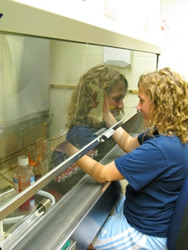Chelsea Koepsell
Understanding Binding Sites of γ-Glutamylcysteine Synthetase
Biochem/MBC, Dr. Kelly
About My Research: 
Glutathione is a molecule that acts as a detoxifying agent in the cells of a wide variety of organisms. It is often found in high concentrations in cancer cells, and has been implicated in chemotherapy resistance; therefore by slowing the production of glutathione, it is believed that cancer cells may become more receptive to chemotherapeutic treatment. In the Kelly lab we have been working to characterize the structure of and identify inhibitors for gamma-glutamylcysteine ligase (γ-GCL), an enzyme that is crucial in the production of glutathione. In order to gain insight into protein structure, we monitor the separation of γ-GCL from other proteins of known molecular weight in a column that separates proteins based upon their size. From these experiments, an approximate weight of γ-GCL can be inferred. Further molecular weight verification is attained by comparing the migration of the enzyme to protein standards on a type of gel that maintains the structural integrity of the enzyme. Inhibition is determined by monitoring the impact of a non-native compound on enzyme activity/function using UV/Vis spectroscopy.
This research was supported by the 2009 MERCK/AAAS Summer Research Grant.
In the student's own words :
"This summer I have come to better understand how, more often than not, people defy stereotypes and expectations. Though something I have viewed over and over since coming to Gustavus, it is still an exciting realization. Professors are approachable, research students do know how to let loose and have fun and people in general actually want to reach out and make connections."
Professional Abstract:
The enzyme gamma-glutamylcysteine ligase (γ-GCL) catalyzes the first and rate-limiting step in the synthesis of glutathione, an important detoxicant in nearly all eukaryotes that has been implicated in chemotherapeutic resistance. In this study, non-substrate amino acid analogs (NSAs) were used to probe active site structural constraints of E. coli g-GCL. Analogs altered kinetics substantially through inhibition or activation depending upon side chain structure, stereochemistry, and concentration of substrate in a manner consistent with uncompetitive binding. Fluorescence titration studies confirmed that the analogs bind to the enzyme and alter the binding affinity of the biological substrate cysteine or a cysteine-mimic. Sigmoidal binding curves suggest that the enzyme exhibits cooperativity in the presence of NSAs, but not a natural substrate, ATP. Size exclusion chromatography and corresponding analysis through native gel electrophoresis results indicate that E. coli gamma-GCL is monomeric. From these results, we hypothesize that there are two distinct binding sites within the monomeric enzyme that can bind either a cysteine substrate or non-substrate analog; the presence of one filled site significantly impacts binding at the other site, leading to unusual patterns in enzyme kinetics.
More student thoughts:
"Research at Gustavus has created stronger relationships between both fellow students and the professors who advise our work. This is important [because] these are the students and professors who are in the classroom and labs working alongside us all school year."
Links:
- Learn more about the Department of Biology
- Learn more about the Department of Chemistry
- Go to the student's Faculty Research Advisor